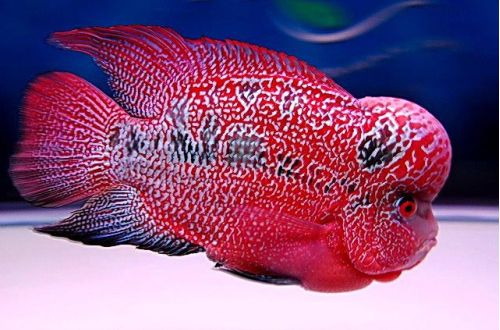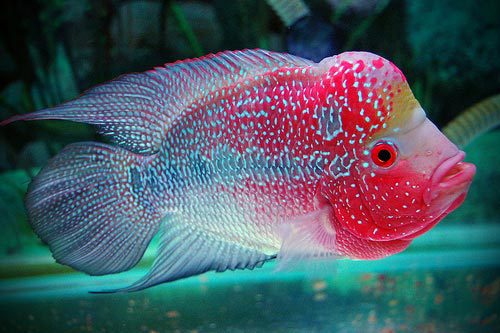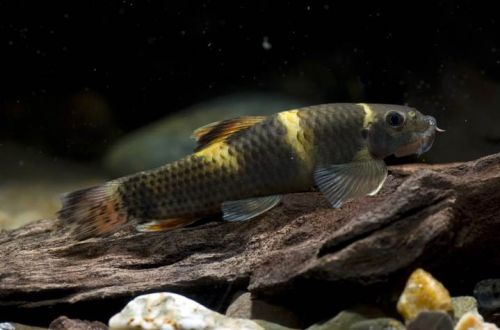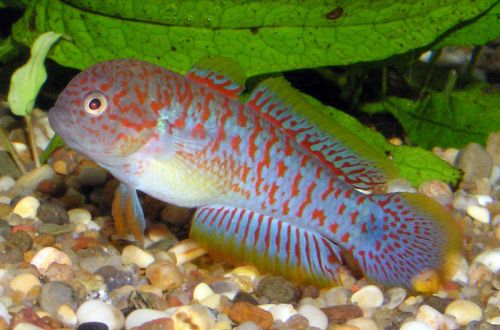
Flowerhorn
Flowerhorn, English name Flowerhorn Cichlid, belongs to the family Cichlidae. An amazing fish in all respects, it has a bright color and an unusual shape. An excellent choice for those who are looking for something unique of its kind. The name is made up of two words “Flower” “Horn”, which together can be translated as Flower or rainbow horn.

This variety of cichlids is a hybrid, the result of systematic crossbreeding of several species, therefore it does not occur in the wild. Unlike other breeding forms, it does not suffer from hereditary diseases and has good endurance, which is extremely rare among hybrids.
Requirements and conditions:
- The volume of the aquarium – from 400 liters.
- Temperature – 27-32°C
- Value pH — 6.5–7.8
- Water hardness – medium hard (9-20dH)
- Substrate type – large smooth stones
- Lighting – moderate
- Brackish water – no
- Water movement – moderate
- Size is about 35 cm.
- Nutrition – meat products
- Life expectancy is 8-10 years.
Contents
Habitat
Not found in the natural environment, bred artificially. The first samples were obtained in Asia in the mid-90s of the last century as a result of crossing some species of South American cichlids. The modern look was obtained in the early 2000s, featuring a bizarre body pattern and pink coloration and the famous protruding occipital hump. In China, it is considered a fish that brings good luck, health and prosperity to its owner. The cost of some specimens can reach thousands of dollars, but fortunately for lovers of exotic species, most fish are still quite affordable.
Description

Large fish, reaching a length of 30–40 cm, depending on the origin. It has a massive oval-shaped body, a distinctive feature is the protruding occipital hump on the head. The pointed dorsal and anal fins are of considerable length and size, the tail is rounded.
Coloration ranges from bluish green metallic on one side to pink and red on the front of the head. The body pattern is dominated by black horizontal markings with white markings throughout. The greatest intensity of coloration is manifested only in adults.
Food
An exceptionally carnivorous species with a large appetite. The variety of food is not so important, you can get by with a couple of products, but the main condition is their quality, this largely affects the color of the fish. They will gladly accept both frozen and live foods: bloodworms, earthworms, crickets, insect larvae, small krill, etc. It is recommended to use specialized vitamin supplements designed for cichlids.
Under no circumstances should beef heart or other meat products of mammals be served, this causes digestive problems and subsequent diseases of the digestive tract. Similar products are often recommended on various sites, but this is a serious mistake that wanders from one article author to another.
Maintenance and care
They are not demanding on the conditions and parameters of water, but at the same time, periodic maintenance should not be neglected. Fish are quite voracious and produce a lot of waste. In addition, the remains of meat food quickly pollute the water, so it is recommended to clean the gravel and replace part of the water (about 25%) every two weeks or a month, depending on the volume of the tank and the degree of contamination. When cleaning, be careful, fish can bite your hand painfully when it is in the water.
The filtration system is important, it must be suitable for the size of the aquarium and effectively cope with a large load. Other necessary equipment includes an aerator, a heater, and a lighting system. All internal devices must be securely reinforced and camouflaged to avoid accidental damage by fish – Flowerhorn is very active.
The design needs a lot of free space for swimming, nothing should hamper movement. The presence of several shelters of rocks or pieces of wood is acceptable, but they should be located near the side walls. The substrate is rocky, with small boulders. Artificial plants are recommended, all others will be quickly destroyed.
Social behavior
An extremely aggressive and territorial species, and is intolerant not only to representatives of other species, but also to its own relatives. Preferably kept alone, or in pairs if breeding is planned, but in a tank with a volume of at least 600 liters, so that each individual has its own plot. In a very large aquarium, it is allowed to keep with several fish of a similar size and temperament, but it is better to entrust the choice of optimal neighbors to a professional.
Sexual differences
There is no reliable method for determining gender, at least there is no single approved list. Each breeder has his own set of signs, and it is worth noting that even a professional does not always manage to correctly identify a male or female.
Breeding / Reproduction
A rare occurrence among hybrids, but they can produce offspring that inherit their traits. However, there are some peculiarities with the choice of partners. It is necessary to know the pedigree of the fish, the partner must come from similar original species, otherwise the offspring will quickly degenerate into simple cichlids. The problem is also the compatibility of fish, they may simply not like each other, and the male may attack the female, even if she comes from the right species.
All of the above points to the difficulty of breeding Flowerhorns at home.
Fish diseases
Fish are characterized by typical diseases of tropical species. In a balanced and clean aquarium, health problems do not occur, problems only start when conditions deteriorate or poor nutrition/malnutrition. Read more about symptoms and treatments in the Aquarium Fish Diseases section.
Features
- Very aggressive species, can attack and even bite the owner’s hand
- Requires high quality meat feed with vitamin supplements
- Not compatible with other fish
- Destroys living plants in the aquarium





